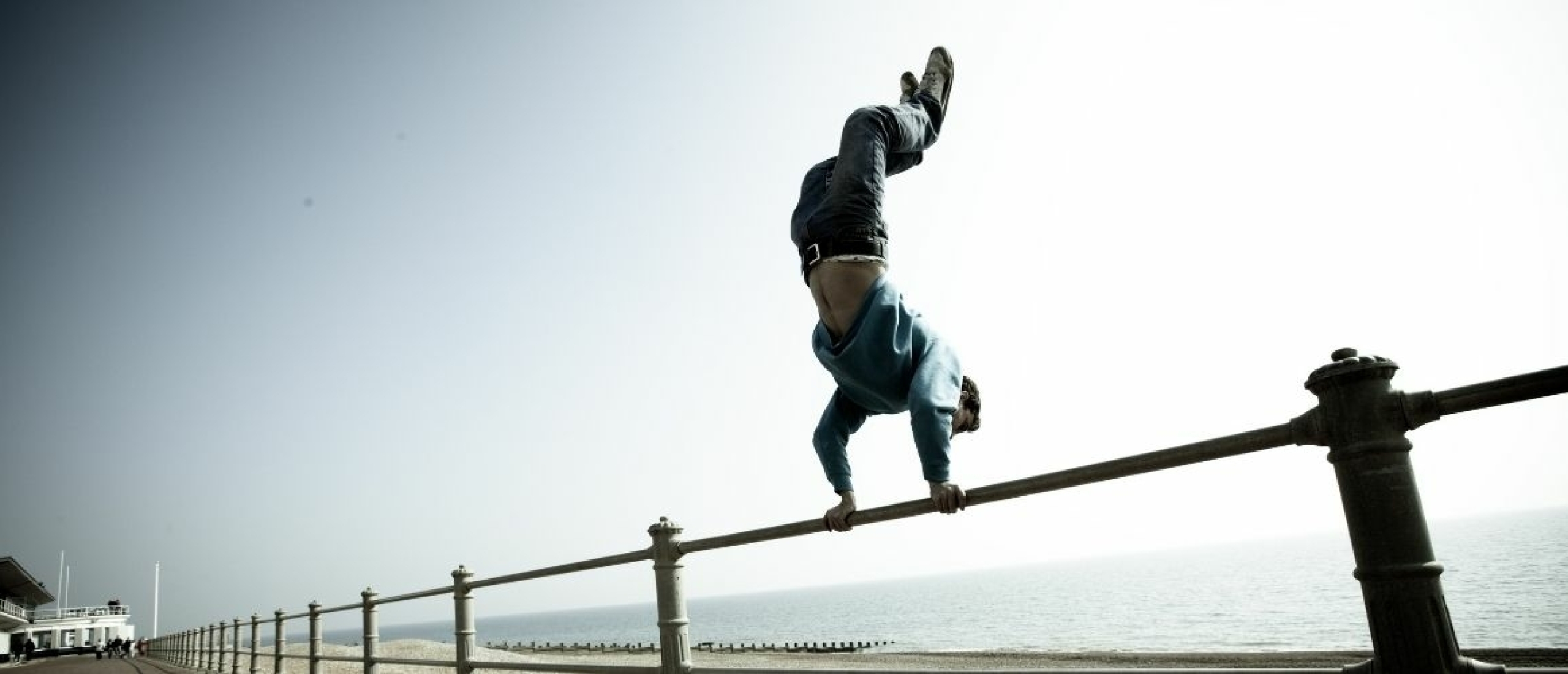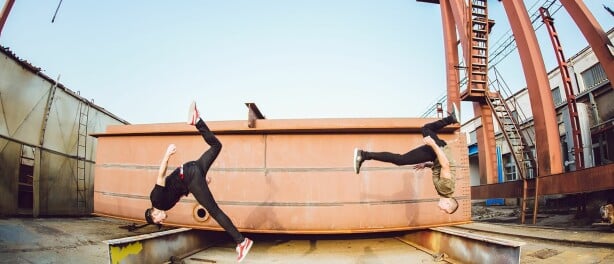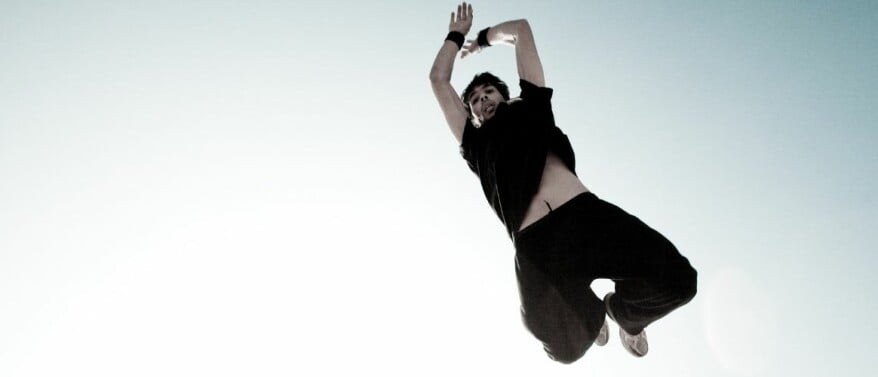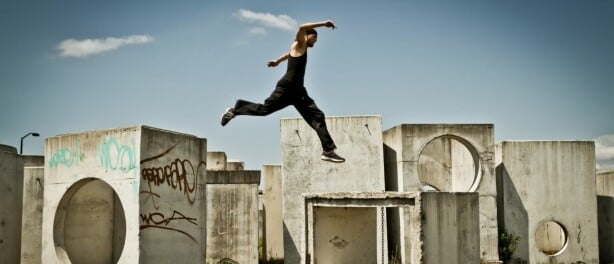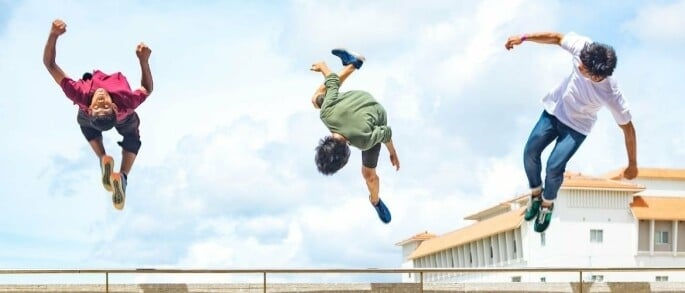Your body is your personal tool that you need to perform movement. In our field, your body is what you earn your living with, but it is also your example, your vehicle and your way of conveying information. In short, your body is very important. You want to take good care of it. One of the most important ways of doing this is by making sure your body is ready for the type of (physical) stress you are going to give your body. You do this with a freerun warming up.
How do you do a freerun warm-up?
The warming up is a moment at the beginning of the lesson in which the students are mentally and physically prepared for the physical and mental stress they will experience during the lesson. This sounds very intense, but with this we mean for example that the wrists are well warmed up before you start to lean on them. If you are going to do a lot of jumping, you need to have enough blood in your muscles and if you are going to break through mental barriers, you want your students to have the right mindset for this. This switch happens mainly during the warm up.
Students will come to your class from many different situations. At home, at school, at work, you name it. The warming up is a perfect transition point from the outside situation to the situation in your class.
Physical
Physically, there are a number of different components you want to achieve in a warm-up:
- Increase in heart rate
- Activate muscles and joints
- Gradual increase of intensity to performance level
Increase in heart rate:
The pupils come in with a 'resting heartbeat'. We want to increase this heart rate to make sure that the blood runs faster through the body and more oxygen is transported to the muscles.
Activate muscles and joints:
By getting moving and increasing the heart rate, the muscles are tightened and activated. The joints also have to work and the fluid in your joints (synovium) will warm up and 'lubricate' the joints better.
Gradual increase of intensity to the level at which performance is required:
During a freerun warm-up, you cannot immediately go from 0% to 100% intensity. It is important that you start slowly and gradually work towards a pace, heart rate and intensity that fits within the framework of the lesson. For example, your first task is not a 100% sprint and your last task cannot be a task where you have to sit still (0%).
Mental
During your freerun warm-up you prepare the pupils for what is to come in your lesson.
The mental components you want to achieve during a warm-up:
- Guide the pupils' concentration towards the content and environment of the lesson
- Getting into the mindset of the lesson
- Increase concentration and self-awareness so that pupils are safer with themselves and others during the lesson.
Why do you warm up?
All of the above are reasons why you should do a warm-up. Warm-ups are also important for;
- better (sports) performance
- long-term preservation of your body
- better metabolism
- less muscle pain
- preventing injuries!
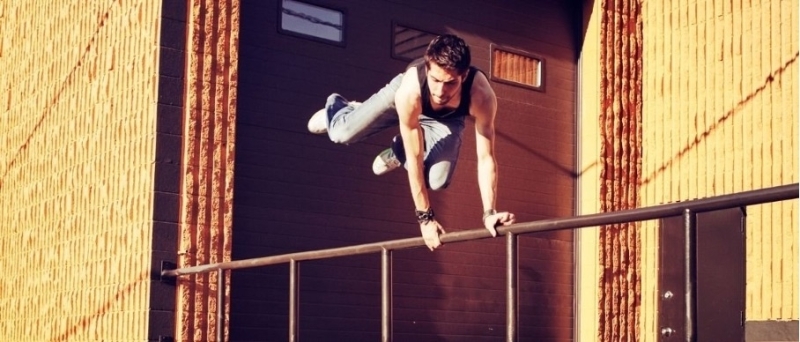
What is a warm-up?
A warming up can be done in many different ways. However, there are several guidelines that you should keep in mind during a warming up.
- Take into account the physical changes you want to achieve in your warm-up.
- Warm up for between 5 and 20 minutes
- Make sure that a warm-up contains a general and a sport-specific part.
A freerun warm-up consists of several components;
- Cardio
- Strength and conditioning
- Quadrupedal Movement
- Loosening of joints
During a freerun warm-up, you obviously want to make sure that the body is fully warmed up for the activities you will be performing next with the participants. The ideal way to do this is to incorporate at least the following concepts into your freerun warm-up. This 'mix' is a good mix of components to get the body ready for the physical effort of freerunning.
Cardio during a freerun warm-up
Any exercise that makes your heart beat faster is considered cardio. For example, running, jogging and cycling. During cardio exercises the blood circulation and oxygen supply speeds up to meet the demand of the muscles. Cardio exercises can always be made heavier by increasing the intensity (how much) or duration.
Strength and Conditioning in a freerun warm-up
Strength and Conditioning is the strengthening of your body through strength exercises. By increasing your strength, your body will be better able to deal with different forms of impact, or unexpected postures.
By conditioning we do not mean improving your condition, but improving the condition of your muscles. Stronger muscles ensure better sports performance and protect your body from injuries.
Strength and conditioning exercises can always be made heavier by extending the duration or increasing the weight.
Quadrupedal Movement during a freerun warm-up
Everything that takes place on the hands and feet is called quadrupedal movement. Quadrupedal means 4-part. By using your hands and feet you have 4 points of support. This way of moving is very close to 'natural movement' or 'animal movement'. Not only will you become very strong from quadrupedal movement but you will also make stronger connections in your hand-eye and hand-foot coordination. You will also learn to tighten parts of your torso that will help you practice different forms of movement. Quadrupedal movement is a well-known form to combat the symptoms of de-conditioning.
Loosening of joints
Before anything happens, it is important to let your body know that something is going to happen by 'loosening up' your joints. With a superficial start that extends to a full range of motion of your joint, you make sure that there is some space in your joint. In addition, the fluid (synovium) that is in your joint will warm up and ensure that your joint moves smoothly and functions optimally.
General warm-up
During the warm-up, you will ideally have a general part and a sport-specific part. During the general part, you want to get the students moving with exercises that put little strain on them.
Sport-specific warm-up
During the sport specific part, you will put more strain on the students and you will move more towards forms or movements that fit the content of your lesson. You prepare muscle groups of your students for the type of movement they are going to make. This can be done with the whole group, in pairs or for example in circuit form.
Hopefully you can get some inspiration for your own freerun classes.

